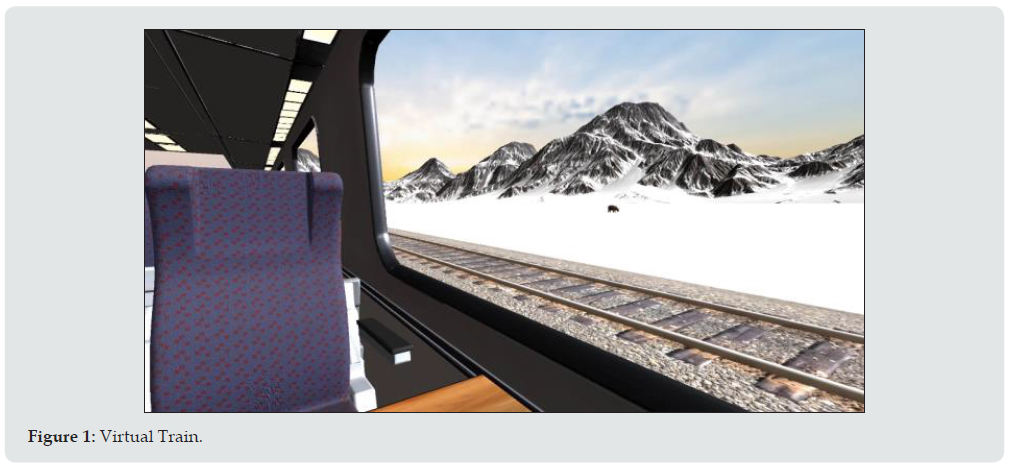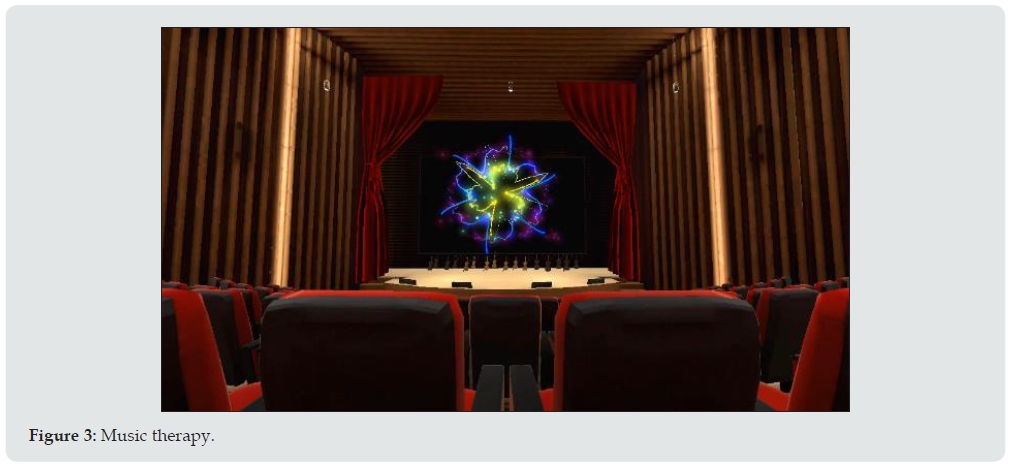
Lupine Publishers Group
Lupine Publishers
Menu
ISSN: 2641-1768
Short CommunicationOpen Access
The Benefits of Virtual Environments and Music Therapy for Alzheimer Volume 6 - Issue 3
Claude Frasson*, Hamdi Ben Abdessalem and Alexie Byrns
- Department of Computer Science, Pavillon Aisenstadt, University of Montreal, Canada
Received:February 28, 2022; Published:March 08, 2022
Corresponding author: Department of Computer Science, Pavillon Aisenstadt, University of Montreal, Canada
DOI: 10.32474/SJPBS.2022.06.000237
Abstract
Alzheimer’s disease is a neurodegenerative disease affecting behavior, cognitive and physical abilities. Negative emotions such anxiety, frustration, or apathy have an impact on these abilities. Virtual reality has been applied in the field of psychology to treat various disorders, including brain damage, anxiety disorders and alleviation of fear. Our research has explored how the integration of virtual reality environments and music therapy can alleviate psychological and cognitive symptoms of the disease.
Keywords: Virtual Reality; Music Therapy; Emotions; Alzheimer; Behavior and Cognition
Alzheimer Disease
Alzheimer’s Disease (AD) is one of the most crucial diseases of our century affecting millions of persons every year. AD is a neurodegenerative disease affecting behavior, cognitive abilities as well as physical conditions. The most notable symptom is the deterioration of both shortand long-term memory. Neural damages in specific regions of the brain interfere with the individual’s capacity to perform activities of daily living, rendering them dependent of caregivers [1]. Negative emotions such as anxiety, frustration, and apathy are common in AD patients which reduce their wellbeing significantly [2].
The progression of the disease manifests itself through many changes at a cognitive, behavioral, and psychological level. The disease can start with Subjective Cognitive Decline (SCD), where the patient notices impairment of their memory, but it cannot be detected with formal tests and does not affect their day to day lives. Some people remain in this state for decades and never progress to AD. People who experience SCD are more at risk of progressing towards the disease than healthy older adults. Those who do progress to AD experience gradual loss of memory and cognitive abilities, characterized among other things by difficulties in problem solving, communication and visuospatial perception. As they reach the later stages of the disease, patients become entirely dependent of their caregivers, apathetic and bedridden. At the basis of this deterioration is the presence of negative emotions which get worse with the time.
Virtual Reality
Virtual Reality (VR) is a means of providing the patients with a sense of presence in an environment that isolates them from external factors able to induce negative emotions. It represents a way to reduce sources of negative emotions also providing a relaxing environment. As of now, most studies focus on how VR can help participants at the cognitive or psychological level [3,4]. VR has been applied in the field of psychology to treat various disorders, including brain damage [5], anxiety disorders [6]) and alleviation of fear [7]. We created, in Unity 3D, a virtual train in which participants are immersed (using a VR headset) and travel virtually looking through the windows to the landscape. They can freely navigate in the train, turning their head and looking around as if they were in a real train (Figure 1). Several external environments are successively displayed. We measured the evolution of emotions using an Electroencephalography (EEG) device, coupled with eye tracking techniques to detect what the subject is looking at.
Results showed that the virtual train helps relax the participants and decreases negative emotions. We also observed that the participants’ performance on memory exercises was improved. Animal-assisted therapy [8] is a stimulation-oriented psychosocial treatment of, based on an interaction between humans and animals for therapeutic purposes. It can help people with Alzheimer’s disease recover from a health problem or mental disorder. We designed another Unity 3D VR environment for zootherapy (Figure 2) including virtual animals such a horse or a dog. The patients are able to interact with the animal using a simple gesture recognition system. They can attract, caress, or give food to the animal. An intelligent agent monitors in real time the interaction with the patient, using gestures interpretation, and also the detection of patient emotions through an EEG device. The interaction provides a decrease of frustration and anxiety, giving room to positive emotions. The advantage of such an approach is to be easy to install without the inconvenience of introducing real animals in the patient’s room.
Music Therapy
Music can positively influence psychological states and can help reduce negative emotions. It provides pleasure, either when actively created or when passively listened to. Its strong ties to the triggering of emotional responses, sometimes even of involuntary movements such as swaying to the beat, may have contributed to its persistence. A study [9] has identified correlations between the music-induced sensation of pleasure and the activity of specific brain structures of the Brain Reward System (BRS) circuitry, a network of interconnected brain structures which play a role in the sensation of pleasure and reward. Within its circuitry, dopamine is the main neurotransmitter which is both synthesized and released [10]. It was shown in [11] that short exposure to rewarding stimuli also reduced cortisol level, a so-called stress hormone, and resulted in better problem-solving performances in stressful situations. Other studies also show that lesions of the amygdala have led to impaired implicit memory [12], suggesting that the BRS plays a role in the recollection of implicit memories. Music [13] activates the BRS through interactions between cortical networks related to audition and to reward.
In this scope, we designed a VR environment (Figure 3) showing a theatre using also Unity 3D software. We virtually placed the participants in the center of the room, on a seat, where they could easily see the stage up front and dynamically rotate their head to visually explore the room. A series of eight 30 second song excerpts were sequentially presented. A neurofeedback agent tracks the emotions of the participants (using EEG) while they listen to the eight songs, detects the song which provokes the best emotional impact and plays this song once again for a longer period. Once the eight song excerpts were listened, the environment was adapted [14] to provide the most beneficial therapeutic impact according to the individual’s preferences. This was calculated based on the participants’ emotional response analyzed through EEG recordings. Indeed, different songs and different visual effects can have varying impacts on individuals. After performing several cognitive tests before and after the songs, results showed that by increasing positive emotions and reducing negative emotions through the activation of the BRS, music improved cognitive functions. Experimental results showed a clear improvement in memory performance for most participants with a pleasant remind of souvenirs attached to the songs.
Conclusion
Through several experiments, we have found that virtual environments can reduce significantly negative emotions of Alzheimer’s patients. Music therapy provides a clear increase of pleasure and positive emotions with a recovery of memories attached to the songs.
Acknowledgement
We acknowledge NSERC-CRD (National Science and Engineering Research Council), Prompt and Beam Me Up for funding this work.

References
- Alzheimer’s Association (2015) 2015 Alzheimer’s disease facts and figures. Alzheimer’s & Dementia 11(3): 332-384.
- Benoit M, Dygai I, Migneco O, Robert P, Bertogliati C, et al. (1999) Behavioral and psychological symptoms in Alzheimer’s disease. Dementia and Geriatric Cognitive Disorders 10: 511–517.
- Appel L (2017) How Virtual Reality could Change Alzheimer Care. Technology.
- Biamonti A, Gramegna S, Imamogullari-Leblanc B (2014) A Design Experience for the Enhancement of the Quality of Life for People with Alzheimer’s Disease. What’s On: Cumulus Spring Conference.
- Rose FD, Brooks, Barbara M, Rizzo AA (2005) Virtual Reality in Brain Damage Rehabilitation: Review. Cyber Psychology & Behavior 8(3): 241-262.
- Gorini A, Riva G (2008) Virtual reality in anxiety disorders: The past and the future. Expert Review of Neurotherapeutics 8(2): 215-233.
- Alvarez RP, Johnson L, Grillon C (2007) Contextual-specificity of short-delay extinction in humans: Renewal of fear-potentiated startle in a virtual environment. Learning & Memory 14(4): 247-253.
- Laforte M (2018) Pet therapy: All you need to know about animal-assiste therapy.
- Brodal HP, Osnes B, Specht K (2017) Listening to rhythmic music reduces connectivity within the basal ganglia and the reward system. Frontiers in neuroscience 11: 153.
- Naranjo CA, Tremblay LK, Busto UE (2001) The role of the brain reward system in depression. Progress in Neuro-Psychopharmacology and Biological Psychiatry 25: 781-823.
- Dutcher JM, Creswell JD (2018) The role of brain reward pathways in stress resilience and health. Neuroscience & Biobehavioral Reviews 95: 559-567.
- Kandel ER, Schwartz JH, Jessell TM, Siegelbaum SA, Hudspeth AJ (2013) Principles of Neural Science, Fifth Edition, McGraw-Hill Education, New York, USA.
- Salimpoor VN, van den Bosch I, Kovacevic N, et al. (2013) Interactions between the nucleus accumbens and auditory cortices predict music reward value. Science 340: 216-219.
- Byrns A, Ben Abdessalem H, Cuesta M (2020) Adaptive Music Therapy for Alzheimer’s Disease Using Virtual Reality. Kumar V, Troussas C (Eds.), Intelligent Tutoring Systems, 16th International Conference, Greece pp. 214-219.

Top Editors
-

Mark E Smith
Bio chemistry
University of Texas Medical Branch, USA -

Lawrence A Presley
Department of Criminal Justice
Liberty University, USA -

Thomas W Miller
Department of Psychiatry
University of Kentucky, USA -

Gjumrakch Aliev
Department of Medicine
Gally International Biomedical Research & Consulting LLC, USA -

Christopher Bryant
Department of Urbanisation and Agricultural
Montreal university, USA -

Robert William Frare
Oral & Maxillofacial Pathology
New York University, USA -

Rudolph Modesto Navari
Gastroenterology and Hepatology
University of Alabama, UK -

Andrew Hague
Department of Medicine
Universities of Bradford, UK -

George Gregory Buttigieg
Maltese College of Obstetrics and Gynaecology, Europe -

Chen-Hsiung Yeh
Oncology
Circulogene Theranostics, England -
.png)
Emilio Bucio-Carrillo
Radiation Chemistry
National University of Mexico, USA -
.jpg)
Casey J Grenier
Analytical Chemistry
Wentworth Institute of Technology, USA -
Hany Atalah
Minimally Invasive Surgery
Mercer University school of Medicine, USA -

Abu-Hussein Muhamad
Pediatric Dentistry
University of Athens , Greece

The annual scholar awards from Lupine Publishers honor a selected number Read More...







